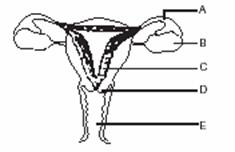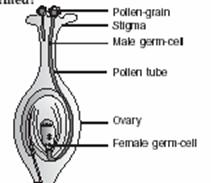CBSE Guess > Papers > Question Papers > Class X > 2008 >Science > Science Theory
Q. 27. (a) Name the parts labelled A, B, C, D and E.

(b) Where do the following functions occur?
(i) Production of an egg
(ii) Fertilisation
(iii) Implantation of zygote
(c) What happens to the lining of uterus
(i) before release of a fertilized egg?
(ii) if no fertilization occurs?
Ans. (a) A . Fallopian tube B . Ovary C . Uterus
D . Cervix E . Vagina
(b)
(i) Production of an egg . Ovary
(ii) Fertilisation . Fallopian tube
(iii) Implantation of zygote . Uterus
(c)
(i) The inner lining of the uterus becomes thick and soft with lot of blood capillaries before release of a fertilized egg. The uterus has to keep this fertilised egg for further development and supply it with food, oxygen etc.
(ii) If no fertilization occurs then the thick uterus lining breaks down along with its blood vessels in the form of vaginal bleeding called menstrual flow.
(a) Draw a diagram showing germination of pollen on stigma of a flower.
(b) Label pollen grain, male germ cells, pollen tube and female germ cell in the above diagram.
(c) How is zygote formed?
Ans a &b

(c) When a pollen grain falls on the stigma of the carpel, it bursts open and grows a pollen tube downwards through the style towards the female gamete in the ovary.
i . A male gamete moves down the pollen tube.
ii. The pollen tube enters the ovule in the ovary.
iii . The tip of pollen tube bursts open and male gamete comes out of pollen tube.
iv. In the ovary, the male gamete of pollen combines with the female gamete or egg present in the ovule to form zygote.
| Science 2008 Question Papers Class X | |||||||
| Delhi | Outside Delhi | Compartment Delhi | Compartment Outside Delhi | ||||
| All Sets (PDF) | Set 1 | Set 1 | |||||
| Set 2 | Set 2 | ||||||
| Set 3 | Set 3 | ||||||